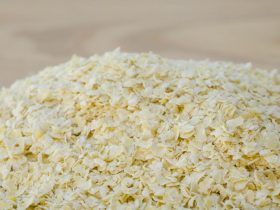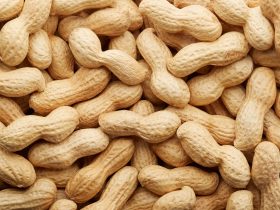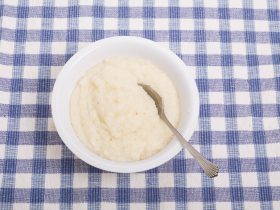Coconut flour has gained popularity for its nutrient and allergen-free composition. For this reason, many people consider trying or shifting to coconut flour from traditional flours. One thing people may want to know before trying coconut flour is its shelf-life.
Most commercially available coconut flours have a shelf life of 12 to 18 months. However, coconut flour can last shorter or longer than its declared shelf life depending on the consumer’s way of handling and storage.
What is Coconut Flour?

Coconut flour is a by-product of coconut milk production. It is produced by drying and grinding the extracted coconut meat. Coconut flour rose to popularity as a markedly better alternative to wheat flours because of its superior nutrient content.
Nutrient Content of Coconut Flour
Studies have found coconut flour to contain significantly higher fiber content when compared to wheat flour; It also has higher amounts of protein and fat. In particular medium-chain triglycerides (MCTs) and plant-based iron.
Allergen Free and Gluten Free
The advantage of coconut flour to other flours such as wheat, soy, and almond is that it is not an allergen. Although soy flour and almond flour contain higher amounts of protein, these flours are allergens. Soybeans, nuts (like almonds), and wheat are one of the most common allergens.
Unlike wheat flour, coconut flour is also gluten-free, which makes it a better option for those who avoid gluten.
Shelf-life and Expiration Terminology Explained
Shelf life is a term used in the food industry which pertains to the period or duration in which a food can be consumed or used. Expiration or expiry dates refer to the last day a food can be consumed; Expiration date is considered the end of the product’s shelf life.
Aside from “Expiration Date” or “Expiry Date”, other food manufacturers use terms such as “Best Before”, “Best If Used By”, and “Use by.” These dates are not regulated by any government agency; Usage and declaration of these dates are purely the prerogative of the manufacturers.
Expiration Date vs Best Before Date
“Expiration Date” is often used as a safety indicator. Expiration date indicates that a product may no longer be safe for consumption. It may also indicate that the nutrient content or composition has deteriorated. Products past its expiration dates are recommended to not be consumed.
“Best Before” date is often used as a quality indicator. Products past the “Best Before” day may still be safe for consumption, but the quality may be deteriorated.
How Are Expiration Dates Determined?
Food manufacturers estimate these dates based on their assessment and evaluation of a product’s quality and safety. Food products undergo shelf life testing to determine its expiration date. Shelf life testing evaluates a food products’ microbiological, chemical, and sensory properties over different time durations.
What Affects a Products’ Expiration Date?
Various factors affect the shelf life or expiration date of a food product. These factors include composition, processing method, packaging, and handling storage.
Water is a major factor that affects how long a product lasts. Water encourages the growth of microorganisms in food. The absence of water or moisture in powdered products such as coconut flour makes it stable and will last longer than wet or liquid products.
Processing method also affects a product’s shelf life. Cooked or heat treated products are usually more stable when compared to uncooked products. A pasteurized or sterilized milk would last longer than fresh milk.
The packaging of a product protects it from environmental factors such as heat, moisture and microorganisms which can trigger spoilage of the food product.
A product can last shorter or longer than its shelf-life depending on the handling and/or storage by consumers. Improper handling and storage can cause product spoilage even before its expiration date. Products can be consumed past its shelf-life if handled and stored properly.
Shelf Life Stability of Coconut Flour

Powdered products such as coconut flour are shelf stable and have a long shelf life. Shelf stable means it can be stored at a room temperature. The stability of coconut flour and all other powdered products is mainly attributed to its low moisture content.
What Makes Coconut Flour Stable?
Spoilage microorganisms such as bacteria and molds need water for growth. Flours and other powdered products have low moisture contents which make them stable. Wheat flours have a moisture content of less than 15%, while various studies found coconut flours to have a moisture content ranging from 3% to 5% (1, 2); These levels are low enough to prevent the growth of bacteria and even molds.
What Can Spoil Coconut Flour?
Food spoilage can be defined as the deterioration of quality or being unsafe for consumption. Coconut flour can be spoiled either way.
Rancidity is a common quality issue for oil or fat containing food products. Rancidity is a chemical reaction that occurs when fats are oxidized upon exposure to light, air, and moisture. This chemical reaction results in discoloration as well as unpleasant odor and flavor. Since coconut flour contains around 10% to 13% fat, it’s possible to turn rancid.
Although coconut flour has a very low moisture content, mold growth may still happen. Improper storage and storage conditions can lead to coconut flour absorbing moisture from the environment. This can cause the coconut flour to form clumps and even encourage mold growth.
How to Store Coconut Flour?
The storage conditions of coconut flour are necessary to maintain quality and safety until or even past its declared shelf life. One easy tip for properly storing coconut flour is to follow the storage conditions indicated on its packaging or label.
Proper Storage Containers
Coconut flour should be stored in an airtight container. It can be any plastic or glass container as long as it is sealed to prevent moisture and oxygen from coming in. Moisture can cause clumps to form in the flour and encourage mold growth. Oxygen can cause oxidation which makes the fat in coconut flour become rancid.
The container preferably should be opaque as light is a catalyst to oxidation. With the presence of oxygen, it increases the rate of oxidation of the fat, making it rancid.
Proper Storage Conditions
The container can be transparent as long as it’s stored in a dark place. It can be on a kitchen shelf or cabinet as long as it’s dark.
The coconut flour should be stored in a cool place. It can be stored at room temperature which is at 77°F or below. Heat is also a catalyst for oxidation which makes the flour turn rancid. Avoid storing the coconut flour in areas with sources of heat such as near a stove or above the refrigerator.
It should be stored in a dry place with no possibility of water getting in the flour. Coconut flour absorbs moisture in the air. This can cause the flour to form clumps and encourage mold growth. The humidity of the storage area should be around 60% or below to prevent moisture absorption.
Coconut flour should not be stored together with items or products with strong odors. Flours absorb odors from the environment so the storage should be odorless and well ventilated.
Refrigerating Coconut Flour
Coconut flour can be stored in the refrigerator but it’s not necessary or recommended. The controlling factor in the stability of coconut flour is moisture content and not temperature; Storing in the refrigerator may cause the coconut flour to absorb moisture.
Although refrigerators have low humidity, it’s also increased every time the door opens. Overall, it is a cool place to store flour but not dry, hence not recommended as a storage location for coconut flour.





Hi, I'm Dom
Dom Eats was started to help other people fall in love with food. While cooking can feel intimidating, it doesn't have to be.